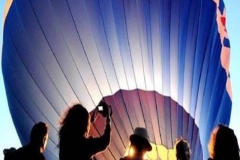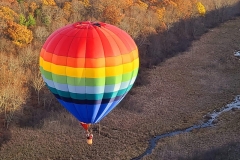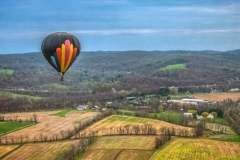FAQs
The Most Frequently Asked Questions About Ballooning...
1. What Are They Made Of?
A balloon system consists of three major parts: the envelope (the ‘balloon’ part), the basket or gondola, and the burner.
The envelope is made of lightweight ripstop nylon or Dacron which is coated with polyurethane to reduce porosity. It contains approximately 1,000 to 1,200 yards of fabric and more than three miles of thread.
The basket, made of wicker or rattan, is both strong and flexible.
The burner is the powerplant of the system. It is fueled by liquid propane carried onboard the balloon and generates up to 20 million BTU’s of hot air per hour.
2. How Big Are The Balloons?
Hot air balloons range in size from small, one-person systems, to balloons that can carry 20 people. The most common sizes are from 65,000 to 105,000 cubic feet, and carry three to six people. When fully inflated, they vary from 60 to 90 feet high, and weigh anywhere from 400 to 700 pounds on the ground. In the air, the complete system, including the air inside the envelope, has a mass of two to four tons./
3. How Do They Work?
Hot air rises. If the air inside the envelope is heated by the burner, the balloon will rise. If the envelope is allowed to cool, or if the hot air is ‘vented’ (allowed to escape) from the balloon, the balloon will descend. An altimeter, a rate-of-climb meter, and an envelope temperature gauge are instruments used in the balloon.
4. How Are They Steered?
It is not possible to steer a balloon since it goes where the wind goes. However, wind conditions vary at different altitudes and provide the balloonist with some limited ability to control the flight path.
5. How Are They Inflated?
The basket is laid on its side and attached to the envelope which is then spread out on the ground. A portable (gasoline powered) fan pushes air into the envelope. When the envelope is almost filled with cold air, the propane burner is ignited and the air inside is heated enough for the balloon to rise to an upright position. With a small amount of additional heat, the balloon will become buoyant. The inflation usually takes about 15 to 20 minutes.
6. How Many People Does It Take To Fly A Balloon?
It takes only one pilot to fly it, but the pilot needs three to four crew people to safely launch a balloon. Duties of the crew include launch preparation, following the balloon in the chase vehicle, obtaining permission from the landowner for landing, and retrieval of the balloon after the flight. Safety is the primary concern of both pilot and crew; followed closely by concern for the rights and protection of property owners on the ground.
7. How Fast? How High? How Long?
Many variables in the weather influence a pilot’s decision to fly. Most pilots agree that a breeze of four to eight miles per hour is acceptable.
Balloons usually stay within 500 – 1,500 feet off the ground, but can go much higher. A few have attained altitudes of well over 60,000 feet.
The length of a balloon flight is determined by many factors, including the outside temperature and the weight carried. On a cold day, with only one person flying, a longer flight is possible. The average length of our balloon rides is 60 to 90 minutes.
8. Who Can Fly A Balloon?
Anyone who earns a balloon pilot rating from the FAA can fly a balloon. To get the rating, one has to fly a minimum number of hours with an instructor, make a solo flight, and pass written, oral and flight tests. There are two categories of license, Private and Commercial.
9. When IS The Best Time To Fly?
The best times to fly are early morning (sunrise) and about two hours before sunset. The winds are usually calmest then.
Ballooning is a fair-weather sport that can be enjoyed year-round.
10. Where Do They Land?
Since a balloon travels with the wind, it is not possible to determine an exact landing site before the flight. A pilot’s first concern is safety. A typical land spot is clear of crops, livestock, small trees, power lines or other obstructions. Whenever possible, permission of the landowner is obtained before landing.
11. How Do You Get Home Again?
After the balloon is launched, the chase crew follows in a chase vehicle. Using maps, two-way radios, and visual contact, they try to be present when the balloon lands. The crew helps the pilot deflate and disassemble the balloon, and the balloon and all the people are driven back to the launch site in the chase vehicle.








 site by adcorp media group
site by adcorp media group